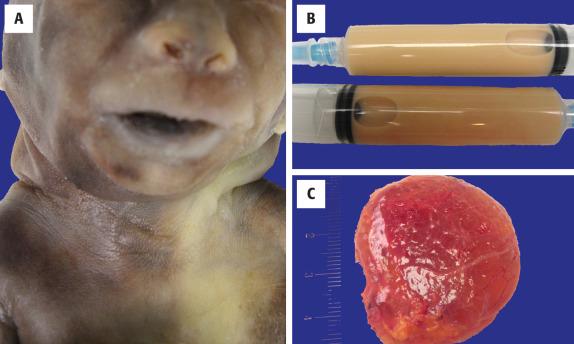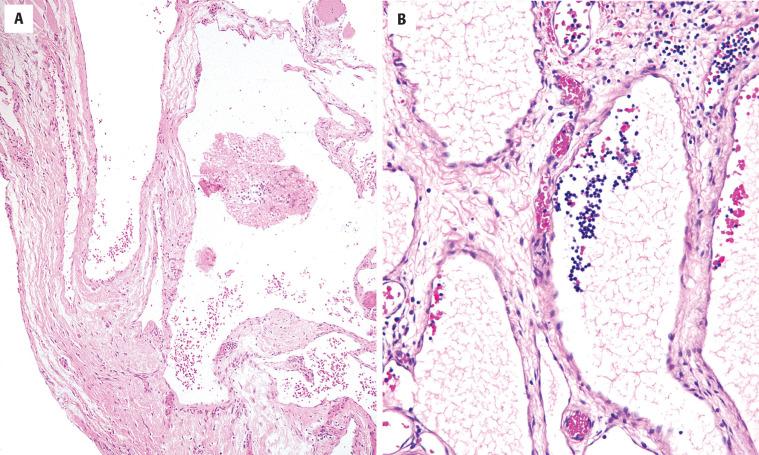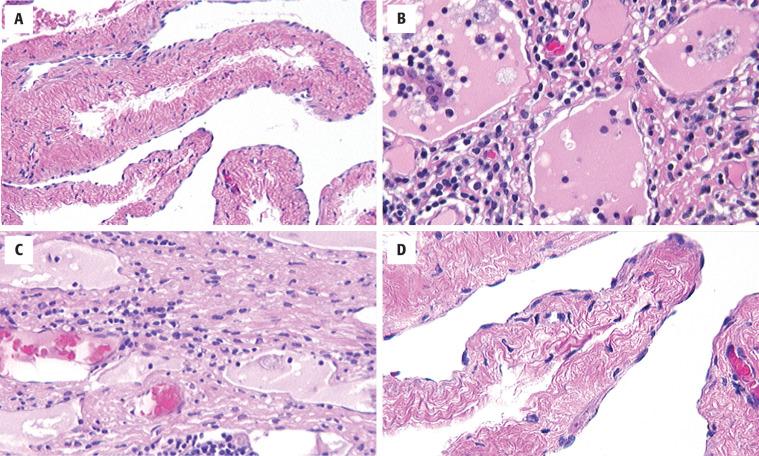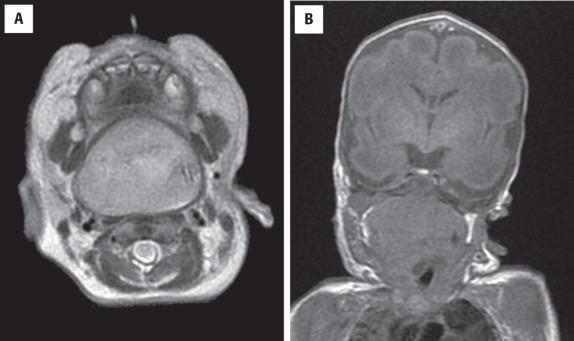Physical Address
304 North Cardinal St.
Dorchester Center, MA 02124
Lymphangiomas are rare congenital lymphatic malformations, with up to 70% reported in the head and neck. They are separated into three types: capillary, cavernous, and cystic (cystic hygroma). Lymphangiomas comprise approximately 25% of all vascular neoplasms in children and adolescents; approximately 25% of cervical cysts are lymphangiomas.
A benign cystic neoplasm composed of dilated lymph vessels
Represents 25% of congenital cervical cysts
Up to 70% of lymphangiomas occur in the head and neck
Mortality 3%-7% (via pressure destruction of adjacent vital structures)
No significant sex difference
Most present shortly after birth and 95% by the second year
Slowly enlarging painless mass
May produce pressure symptoms owing to its size
Associated with fetal hydrops and Turner syndrome
May become secondarily infected
Surgery is the treatment of choice; sclerosing agents and laser can be used
Up to 50% recurrence depending on size and site of lesion (due to incomplete excision)
Approximately two-thirds of lymphangiomas are noted shortly after birth, and 95% are present by the end of the second year of life. Cystic hygroma may also be detected in utero with ultrasonography. Cystic hygroma may be associated with fetal hydrops and several genetic abnormalities, most notably Turner syndrome ( Fig. 21.1 ) but also Noonan syndrome and trisomies 13, 18, and 21. In general, symptoms are related to pressure caused by the slowly enlarging mass or extension of the mass into the posterior neck or, less commonly, into the anterior compartment, cheek, mediastinum, or axilla. When the hygroma is located superior to the hyoid bone, it may cause dysphagia or airway compression. Ultrasound will show a cystic lesion, frequently identified prenatally, while computed tomography (CT) studies will show a nonenhancing multilocular cystic mass.

Cavernous lymphangioma forms an ill-defined, spongy, compressible mass and is found most commonly in the tongue, cheek, floor of mouth, and lips; it is uncommon in the soft tissues. In contrast, capillary lymphangioma is usually confined to the skin and is clinically the least significant of the three types.
Cystic lymphangiomas (hygromas) vary from a single soft mass with a pseudocontour to lobulated multicystic masses ( Fig. 21.1 ). They contain clear to white-turbid fluid, described as milk-like ( Fig. 21.1 ). Histologically, they consist of dilated, thin-walled spaces filled with eosinophilic, proteinaceous fluid and lined by flat endothelial cells ( Fig. 21.2 ). The intervening stroma contains scattered lymphoid aggregates and wisps of smooth muscle fibers ( Fig. 21.3 ). Fibrosis may be increased in lesions that have been present for a long time.


Endothelial markers (factor VIII–related antigen [FVIII-RAg], CD31, CD34, and Ulex europaeus ) can be expressed by endothelial cells in both hemangiomas and lymphangiomas. D2-40 (podoplanin) may be a lymphatic-specific marker, along with CD9 and lymphatic vessel endothelial receptor 1 (LYVE-1), although podoplanin may be easier to interpret.
Sponge-like cystic mass
Dilated, thin-walled spaces filled with proteinaceous fluid
Lined by flat endothelial cells
Lymphoid aggregates in stroma
Wisps of smooth muscle in the wall
Positive with factor VIII–related antigen, CD31, CD34, Ulex europaeus
D2-40 (podoplanin) may be specific lymphatic marker (also CD9 and LYVE-1, although less common)
Cavernous hemangioma, metastatic papillary thyroid carcinoma
The most common differential diagnosis is with cavernous hemangioma. Lymphangioma contains proteinaceous fluid and the surrounding tissues are usually infiltrated by lymphocytes, whereas cavernous hemangiomas are filled with red blood cells and lack valve structures. Metastatic papillary thyroid carcinoma may have flattened cells along the spaces, but TTF1 and/or thyroglobulin will be positive. Furthermore, a lymph node architecture should be recognizable, often at the periphery.
Mortality rates are between 3% and 7%, specifically related to pressure destruction of vital structures of the neck. Lymphangiomas may occasionally become infected and may cause difficulty swallowing or respiratory distress. Surgery is the treatment of choice, while laser treatment or injected sclerosing agents (such as bleomycin) are alternative therapies. Recurrence rates range from 15% to 50% and are highest when the lymphangioma is incompletely removed. Malignant transformation is not documented.
Teratomas are neoplasms composed of elements from each of the three germ cell layers (ectoderm, endoderm, and mesoderm). About 1 in 4000 live births have a teratoma, with approximately 2% involving the head and neck, most commonly the neck, oropharynx, nasopharynx, and orbit. Specifically, cervical teratomas represent less than 3% of all teratomas and less than 1% of all neck masses in children. Teratomas are separated, histologically, into mature or immature, solid or cystic, and are classified as benign or malignant depending on the degree of tissue maturation. In general, teratomas of the neck in neonates or infants are clinically benign, although they may be histologically mature or immature. By comparison, teratomas in adults are more likely to be clinically malignant and histologically immature.
More than 90% of cervical teratomas occur in neonates or infants and are rare in patients older than 1 year. They occur with similar frequency in boys and girls. In addition to a neck mass, severe respiratory distress is notable in neonates, frequently leading to airway compromise and requiring immediate surgery. Polyhydramnios and other malformations may be seen in approximately 20% of patients, many of whom will show an elevated α-fetoprotein concentration in amniotic fluid. Failure of midline structure development may result in fetal demise, even though the lesion is histologically benign. If detected prenatally by ultrasonographic examination, surgical planning may yield a better outcome. CT or magnetic resonance imaging (MRI) usually shows a multilocular mass ( Fig. 21.4 ). Cervical teratomas in adults are extremely rare, with patients reporting a rapidly enlarging neck mass.
Neoplasm composed of mature or immature elements from ectoderm, endoderm, and mesoderm
Cervical teratomas represent 3% of all teratomas
Less than 1% of pediatric neck masses
High morbidity but low mortality in neonates and infants
High mortality in older children and adults
Equal sex distribution
More than 90% occur in neonates or infants
Neck mass
Respiratory distress
Frequent association with congenital malformations
Polyhydramnios seen in 20% of neonatal lesions
Prognosis is very good in neonates and infants but guarded in older children and adults
Surgery

Become a Clinical Tree membership for Full access and enjoy Unlimited articles
If you are a member. Log in here